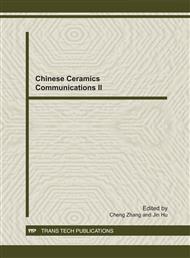p.167
p.171
p.175
p.179
p.183
p.187
p.191
p.195
p.199
Fabrication of Aluminium Nitride by Electrophoretic Deposition
Abstract:
The electrophoretic deposition (EPD) technique has been developed to prepare AlN ceramics and the topic of this paper was the investigation of the AlN ceramic suspensions for electrophoretic deposition. The only addition of triethylamine didn’t promote the hydrolysis of AlN powder in 95% ethanol. The absorption of the polyacrylic acid (PAA) resulted in an increased Zeta potential, indicating that PAA is a very effective dispersant for the AlN and Y2O3 powders. Furthermore, by adding a combination of PAA and triethylamine, an stable AlN suspension could be obtained which was necessary for realising a high packing density in the electrophoretically deposited green bodies. The conductivity measurements indicated that suspension conductivity was lower than liquid conductivity. The lower conductivities of the suspensions could be explained by the fact that in concentrated suspensions the free ionic species are hindered in their movement by the particles. The conductivity of the centrifugate was higher than that of the suspension. It can be concluded that during the EPD the current in the suspension is mainly carried by the free ionic species. The transport of positively charged ionic species to the upper electrode (cathode) was slower than their consumption by the electrode reaction, an increased concentration overvoltage caused a significant increase in total electrical resistance due to the higher potential drop at the cathode. Finally, the EPD was usually stopped according to the increase in potential drop.
Info:
Periodical:
Pages:
183-186
Citation:
Online since:
November 2011
Authors:
Price:
Сopyright:
© 2012 Trans Tech Publications Ltd. All Rights Reserved
Share:
Citation:


